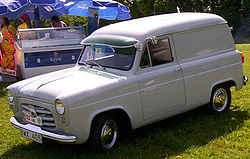
Thames 300E
Encyclopedia

Panel van
A panel van is a form of solid van, smaller than a lorry or truck, without rear side windows...
produced by Ford of Britain
Ford of Britain
Ford of Britain is a British wholly owned subsidiary of Ford of Europe, a subsidiary of Ford Motor Company. Its business started in 1909 and has its registered office in Brentwood, Essex...
from 1954 to 1961. The Thames (or Thames Trader) name was given to all available sizes of commercial vehicle produced by Ford in Britain during the 1950s and until the arrival in 1965 of the UK built Ford Transit.
The 300E was introduced in July 1954, based on the Ford Anglia / Prefect 100E saloon range and it shared its bodyshell with the station wagon versions of the line. and 1172 cc sidevalve four cylinder engine with those models. Oddly, the bodyshell was optimized for use as a panel truck rather than a wagon with its two, short passenger doors and shorter overall length than the sedans. Initially produced only as a single model with 5 cwt
Hundredweight
The hundredweight or centum weight is a unit of mass defined in terms of the pound . The definition used in Britain differs from that used in North America. The two are distinguished by the terms long hundredweight and short hundredweight:* The long hundredweight is defined as 112 lb, which...
(250 kg) carrying capacity, the range was later expanded with the introduction of Standard and Deluxe 7 cwt (350 kg) variants. All three offered the same 66 cubic feet (1.9 m³) load volume. Production totalled 196,885 examples comprising 139,267 5 cwt, 10,056 Standard 7 cwt and 47,562 Deluxe 7 cwt units.
300E production ended in April 1961 and the van's replacement, the Anglia 105E
Ford Anglia
The 1949 model, code E494A, was a makeover of the previous model with a rather more 1940s style front-end, including the sloped, twin-lobed radiator grille. Again it was a very spartan vehicle and in 1948 was Britain's lowest priced four wheel car....
based Thames 307E
Ford Thames 307E
The Ford Thames 307E is a small panel van based on the recently introduced Ford Anglia 105E and launched by Ford of Britain in the summer of 1961. It replaced the Ford Thames 300E and, like its predecessor it was more usually known to contemporaries as the Ford 5 cwt or the Ford 7 cwt van...
, was introduced in June of the same year.

